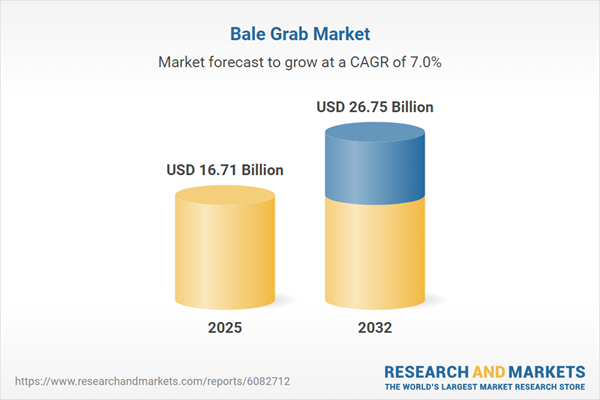Speak directly to the analyst to clarify any post sales queries you may have.
The bale grab market is transforming how senior leaders approach material handling, with rapid technology adoption and supply chain adjustment shaping new standards of operational resilience and efficiency. As industries respond to evolving market pressures and regulatory demands, organizations that prioritize robust, adaptable solutions are better positioned for long-term value.
Market Snapshot: Bale Grab Market Growth and Trends
The bale grab market expanded from USD 15.61 billion in 2024 to USD 16.71 billion in 2025 and is forecast to reach USD 26.75 billion by 2032, reflecting a CAGR of 6.95%. This sustained growth is driven by amplified demand across industrial sectors, heightened regulatory scrutiny, and increasing integration of advanced technologies within equipment platforms. As organizations sharpen their focus on efficiency and safety, capital expenditures are shifting toward resilient and high-performing handling solutions. The sector’s innovation is accompanied by evolving supply strategies as global conditions require agile responses and new procurement models.
Bale Grab Market Scope & Segmentation
- Product Types: Hydraulic grabs—including clamshell and tine variants—are designed for energy-efficient precision, while mechanical options deliver versatility for various handling contexts. Remote control units support operator safety and adaptability.
- Applications: Key applications extend to routine material handling, efficient management of bulk and containerized goods, and specialized use in metal, paper, and plastic recycling. Bale grabs also streamline scrap sorting and waste management across industrial and residential sectors, supporting operational uptime and sustainability commitments.
- End-Use Industries: Core industries include agriculture (both crop and livestock sectors), commercial and infrastructure construction, dedicated recycling facilities for metal and plastics, ferrous and non-ferrous scrap yards, and municipal as well as industrial waste management entities. Each segment leverages bale grab technology to optimize process flows while meeting compliance mandates.
- Distribution Channels: Access to bale grab solutions is enabled by a network of independent distributors, original equipment manufacturers, direct sales outlets, e-commerce platforms, official manufacturer websites, and flexible leasing or rental services, which collectively provide tailored options for different operational requirements and procurement cycles.
- Regions: Major regional markets comprise the Americas, Europe, Middle East & Africa, and Asia-Pacific. Each has distinct requirements shaped by local compliance regimes, supply chain realities, and customer needs, prompting suppliers to adjust service offerings and technology deployment accordingly.
- Leading Companies: Noteworthy players include Cascade Corporation, Bolzoni Auramo S.p.A, Kaup GmbH & Co. KG, Hyster-Yale Group, Toyota Material Handling, Linde Material Handling, Mitsubishi Logisnext, Manitou BF, Crown Equipment, and Enerpac Tool Group. These organizations drive sectoral innovation and guide technology trends through product portfolios and service integration.
Key Takeaways: Strategic Insights for Senior Leaders
- Increased automation and remote-control features are enhancing operational efficiency by reducing manual intervention and elevating workplace safety for operators.
- Modern hydraulic systems and advancements in material science are producing lighter, more durable equipment that contributes to reduced life-cycle costs while aligning with sustainability objectives.
- Collaboration with local component suppliers is building supply chain flexibility, which supports business continuity amid fluctuations in global trade conditions and tariffs.
- Regional operational strategies are adapting: while North American buyers often emphasize local partnerships to manage regulatory complexity, European organizations are advancing energy-efficient, circular economy practices as standard operating principles.
- Expanded distribution strategies—especially through digital channels and lease models—are streamlining procurement and creating an environment for faster adaptation to shifting demand patterns.
Tariff Impact
Recent changes to tariffs, specifically on imported steel and vital handling components for the bale grab market in the United States, have necessitated a strategic reevaluation of supply chains. Many manufacturers now prioritize regional sourcing, both to stabilize input costs and to minimize exposure to disruptions affecting delivery reliability. This momentum toward domestic supply reinforces more predictable total landed costs and strengthens resilience across procurement processes, while also enabling flexible renegotiation of supplier agreements in response to changing logistics and market conditions.
Methodology & Data Sources
This analysis applies a comprehensive mixed-methods framework, including interviews with experienced industry professionals, targeted end-user surveys, and review of technical literature and proprietary data. Rigorous cross-validation ensures the accuracy and reliability of trend identification and market behavior insights.
Why This Report Matters
- Delivers tactical and strategic guidance for investments, supplier engagement, and technology integration in the bale grab market, supporting leaders with actionable insights aligned to emerging challenges.
- Equips senior executives to proactively anticipate regulatory and technological trends, ensuring operational models are adaptive to both immediate and long-term global pressures.
- Enables benchmarking of adoption practices, innovation strategies, and channel performance across competitors and geographies, informing confident and data-driven market positioning.
Conclusion
The bale grab market continues to evolve through innovation, regional supply localization, and increased sustainability. Leveraging these insights empowers organizations to strengthen their competitive position and navigate industry shifts with confidence.
Table of Contents
3. Executive Summary
4. Market Overview
7. Cumulative Impact of Artificial Intelligence 2025
Companies Mentioned
The companies profiled in this Bale Grab market report include:- Cascade Corporation
- Bolzoni Auramo S.p.A
- Kaup GmbH & Co. KG
- Hyster-Yale Group, Inc.
- Toyota Material Handling, U.S.A., Inc.
- Linde Material Handling GmbH
- Mitsubishi Logisnext Co., Ltd.
- Manitou BF S.A.
- Crown Equipment Corporation
- Enerpac Tool Group Corporation
Table Information
| Report Attribute | Details |
|---|---|
| No. of Pages | 194 |
| Published | November 2025 |
| Forecast Period | 2025 - 2032 |
| Estimated Market Value ( USD | $ 16.71 Billion |
| Forecasted Market Value ( USD | $ 26.75 Billion |
| Compound Annual Growth Rate | 6.9% |
| Regions Covered | Global |
| No. of Companies Mentioned | 11 |









